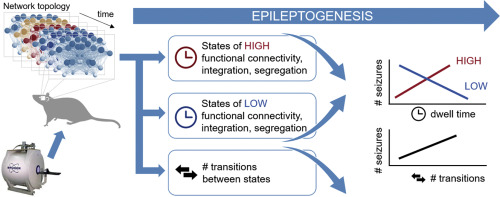当前位置:
X-MOL 学术
›
Neurobiol. Dis.
›
论文详情
Our official English website, www.x-mol.net, welcomes your feedback! (Note: you will need to create a separate account there.)
Dynamic functional connectivity and graph theory metrics in a rat model of temporal lobe epilepsy reveal a preference for brain states with a lower functional connectivity, segregation and integration.
Neurobiology of Disease ( IF 6.1 ) Pub Date : 2020-02-19 , DOI: 10.1016/j.nbd.2020.104808 Emma Christiaen 1 , Marie-Gabrielle Goossens 2 , Benedicte Descamps 1 , Lars E Larsen 3 , Paul Boon 2 , Robrecht Raedt 2 , Christian Vanhove 1
Neurobiology of Disease ( IF 6.1 ) Pub Date : 2020-02-19 , DOI: 10.1016/j.nbd.2020.104808 Emma Christiaen 1 , Marie-Gabrielle Goossens 2 , Benedicte Descamps 1 , Lars E Larsen 3 , Paul Boon 2 , Robrecht Raedt 2 , Christian Vanhove 1
Affiliation

|
Epilepsy is a neurological disorder characterized by recurrent epileptic seizures. The involvement of abnormal functional brain networks in the development of epilepsy and its comorbidities has been demonstrated by electrophysiological and neuroimaging studies in patients with epilepsy. This longitudinal study investigated changes in dynamic functional connectivity (dFC) and network topology during the development of epilepsy using the intraperitoneal kainic acid (IPKA) rat model of temporal lobe epilepsy (TLE). Resting state functional magnetic resonance images (rsfMRI) of 20 IPKA animals and 7 healthy control animals were acquired before and 1, 3, 6, 10 and 16 weeks after status epilepticus (SE) under medetomidine anaesthesia using a 7 T MRI system. Starting from 17 weeks post-SE, hippocampal EEG was recorded to determine the mean daily seizure frequency of each animal. Dynamic FC was assessed by calculating the correlation matrices between fMRI time series of predefined regions of interest within a sliding window of 50 s using a step length of 2 s. The matrices were classified into 6 FC states, each characterized by a correlation matrix, using k-means clustering. In addition, several time-variable graph theoretical network metrics were calculated from the time-varying correlation matrices and classified into 6 states of functional network topology, each characterized by a combination of network metrics. Our results showed that FC states with a lower mean functional connectivity, lower segregation and integration occurred more often in IPKA animals compared to control animals. Functional connectivity also became less variable during epileptogenesis. In addition, average daily seizure frequency was positively correlated with percentage dwell time (i.e. how often a state occurs) in states with high mean functional connectivity, high segregation and integration, and with the number of transitions between states, while negatively correlated with percentage dwell time in states with a low mean functional connectivity, low segregation and low integration. This indicates that animals that dwell in states of higher functional connectivity, higher segregation and higher integration, and that switch more often between states, have more seizures.
中文翻译:

颞叶癫痫大鼠模型中的动态功能连接和图论指标揭示了对功能连接,隔离和整合性较低的大脑状态的偏爱。
癫痫病是一种以复发性癫痫发作为特征的神经系统疾病。癫痫患者的电生理和神经影像学研究已证明异常功能性脑网络参与癫痫的发展及其合并症。这项纵向研究使用颞叶癫痫(TLE)腹膜内海藻酸(IPKA)大鼠模型研究了癫痫发展过程中动态功能连接(dFC)和网络拓扑的变化。使用7 T MRI系统在美托咪定麻醉下的癫痫持续状态(SE)之前和之后,1、3、6、10和16周获取20只IPKA动物和7只健康对照动物的静止状态功能磁共振图像(rsfMRI)。从SE后的17周开始,记录海马脑电图以确定每只动物的平均每日癫痫发作频率。通过使用2 s的步长在50 s的滑动窗口内计算预定义的感兴趣区域的fMRI时间序列之间的相关矩阵,可以评估动态FC。使用k均值聚类,将矩阵分为6个FC状态,每个状态均具有相关矩阵。此外,根据时变相关矩阵计算了几个时变图理论网络度量,并将其分为功能网络拓扑的6种状态,每种状态都由网络度量的组合来表征。我们的结果表明,与对照动物相比,IPKA动物中具有较低平均功能连通性,较低的分离和整合的FC状态更为常见。在癫痫发生过程中,功能连接性也变得越来越少。此外,在具有高平均功能连接性,高隔离和整合状态的州,平均每日癫痫发作频率与停留时间百分比(即状态发生的频率)呈正相关,并且与状态之间的转换次数呈正相关,而与停留时间百分比呈负相关平均功能连接性低,隔离度低和集成度低的州的时间。这表明,居住在功能连接性更高,隔离度更高和整合度更高的状态下并且在状态之间进行切换的频率更高的动物会出现更多的癫痫发作。平均功能连接性高,隔离和集成度高,状态间转换次数高的州,而平均功能连接性低,隔离性低和集成度低的州中,与停留时间百分比负相关。这表明,居住在功能连接性更高,隔离度更高和整合度更高的状态下并且在状态之间进行切换的频率更高的动物会出现更多的癫痫发作。平均功能连接性高,隔离和集成度高,状态间转换次数高的州,而平均功能连接性低,隔离性低和集成度低的州中,与停留时间百分比负相关。这表明,居住在功能连接性更高,隔离度更高和整合度更高的状态下并且在状态之间进行切换的频率更高的动物会出现更多的癫痫发作。
更新日期:2020-02-20
中文翻译:

颞叶癫痫大鼠模型中的动态功能连接和图论指标揭示了对功能连接,隔离和整合性较低的大脑状态的偏爱。
癫痫病是一种以复发性癫痫发作为特征的神经系统疾病。癫痫患者的电生理和神经影像学研究已证明异常功能性脑网络参与癫痫的发展及其合并症。这项纵向研究使用颞叶癫痫(TLE)腹膜内海藻酸(IPKA)大鼠模型研究了癫痫发展过程中动态功能连接(dFC)和网络拓扑的变化。使用7 T MRI系统在美托咪定麻醉下的癫痫持续状态(SE)之前和之后,1、3、6、10和16周获取20只IPKA动物和7只健康对照动物的静止状态功能磁共振图像(rsfMRI)。从SE后的17周开始,记录海马脑电图以确定每只动物的平均每日癫痫发作频率。通过使用2 s的步长在50 s的滑动窗口内计算预定义的感兴趣区域的fMRI时间序列之间的相关矩阵,可以评估动态FC。使用k均值聚类,将矩阵分为6个FC状态,每个状态均具有相关矩阵。此外,根据时变相关矩阵计算了几个时变图理论网络度量,并将其分为功能网络拓扑的6种状态,每种状态都由网络度量的组合来表征。我们的结果表明,与对照动物相比,IPKA动物中具有较低平均功能连通性,较低的分离和整合的FC状态更为常见。在癫痫发生过程中,功能连接性也变得越来越少。此外,在具有高平均功能连接性,高隔离和整合状态的州,平均每日癫痫发作频率与停留时间百分比(即状态发生的频率)呈正相关,并且与状态之间的转换次数呈正相关,而与停留时间百分比呈负相关平均功能连接性低,隔离度低和集成度低的州的时间。这表明,居住在功能连接性更高,隔离度更高和整合度更高的状态下并且在状态之间进行切换的频率更高的动物会出现更多的癫痫发作。平均功能连接性高,隔离和集成度高,状态间转换次数高的州,而平均功能连接性低,隔离性低和集成度低的州中,与停留时间百分比负相关。这表明,居住在功能连接性更高,隔离度更高和整合度更高的状态下并且在状态之间进行切换的频率更高的动物会出现更多的癫痫发作。平均功能连接性高,隔离和集成度高,状态间转换次数高的州,而平均功能连接性低,隔离性低和集成度低的州中,与停留时间百分比负相关。这表明,居住在功能连接性更高,隔离度更高和整合度更高的状态下并且在状态之间进行切换的频率更高的动物会出现更多的癫痫发作。


























 京公网安备 11010802027423号
京公网安备 11010802027423号